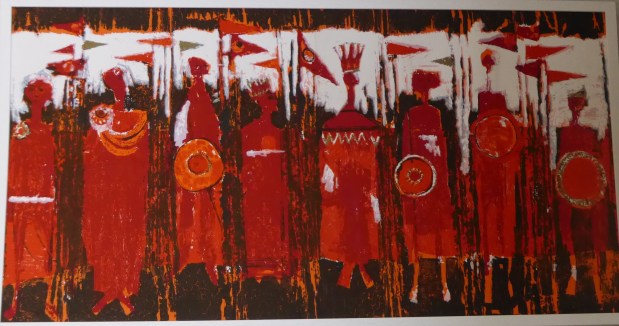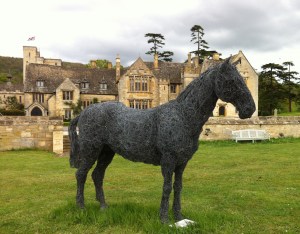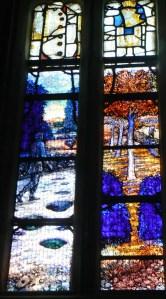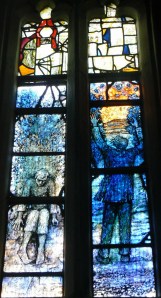
The weather was atrocious when I finally managed to visit the Tower of London with a friend. After an unseasonably warm October, November has arrived with a splash. It rained non-stop while we were at the Tower. Not gentle rain, or refreshing rain, but relentless, heavy, pounding rain, that ran in waves down the sloping entrance, soaking my shoes and the bottom of my trousers. My daughter has this theory that if it is raining in Barcelona where she lives, it will be dry in London and vice versa. She happened to ring me just as I was leaving the house clad in wellies and mac. But as there was a thunderstorm and heavy rain in Barcelona, she said I wouldn’t need them so I changed. She was wrong. I got soaked!
Despite the rain, the Tower was packed with visitors and I was impressed by how cheerful and friendly they were. Most of the people I spoke to in the extremely long queues were from London or nearby counties of Kent and Essex. Some said they hadn’t been to the Tower since they were children on a school visit. Others, like me, had made a day trip involving hours on public transport- coaches, trains, buses and the underground. Travelling, walking, and queuing all in torrential rain. All had made the effort because they were keen to see the installation officially called, “Blood Swept Lands and Seas of Red”, but generally known by the people as ~ The Poppies!
Poppies of course are an emotive symbol, used since the 1920s by the Royal British Legion to raise funds for their charitable work, ‘to the memory of the fallen and the future of the living’. Although they are controversial, most people in the UK seem to wear them to show respect for those who fought and died in previous conflicts, and solidarity with those serving in the armed forces today. The tradition was inspired by the poem, In Flanders Fields, by John McCrae. The story goes that when his friend, Alexis Helmer was killed at Ypres in 1915, the Canadian doctor, Major John McCrae, conducted the burial. In his grief he was moved by the beauty of the wild red poppies growing amongst the horror of the graves. The sight inspired McCrae to write this famous poem.
In Flanders fields the poppies blow
Between the crosses, row on row,
That mark our place; and in the sky
The larks, still bravely singing, fly
Scarce heard amid the guns below.
We are the Dead. Short days ago
We lived, felt dawn, saw sunset glow,
Loved and were loved, and now we lie
In Flanders fields.
Take up our quarrel with the foe:
To you from failing hands we throw
The torch; be yours to hold it high.
If ye break faith with us who die
We shall not sleep, though poppies grow
In Flanders fields.
The poppies forming the installation at the Tower, all 888,246 of them, were handmade under the direction of the ceramic artist Paul Cummins to commemorate the centenary of the outbreak of World War One. The artist reportedly said that he took his inspiration from the words of an unknown soldier from Derby who wrote that all his friends, indeed everyone he cared about, had been killed in that dreadful war. He described, “Blood swept lands and seas of red, where angels dare to tread”. The ceramic poppies, each representing a British or Commonwealth fatality in WW1, were ‘planted’ by volunteers in the moat around the Tower of London; not haphazardly, but artistically arranged by the stage designer, Tom Piper. Now complete, they spill over battlements, around walls and out of windows, covering the grassy moat with a red river of biblical proportions. There is a very appropriate poem which reflects not only the poppies but how I feel about the whole experience:
London by William Blake
I wandered through each chartered street,
Near where the chartered Thames does flow,
A mark in every face I meet,
Marks of weakness, marks of woe.
In every cry of every man,
In every infant’s cry of fear,
In every voice, in every ban,
The mind-forged manacles I hear:
How the chimney-sweeper’s cry
Every blackening church appals,
And the hapless soldier’s sigh
Runs in blood down palace-walls.
The Journalist, Jonathan Jones has been criticised in some quarters of the media for his opinion that the poppies at the Tower of London are “fake, trite and inward-looking – a UKIP-style memorial”, theguardian.com, 28 October). I found his comments shocking, but thought provoking.
My impression was of a river of blood flowing around the tower, but outside of the establishment in every sense of the word. Inside, the building protects and reflects power, treasures, pomp, ceremony, privilege, and a dark side to our history ~ cruelty, torture, imprisonment and murder.
Significantly, many of the people, probably the majority, who came to see the poppies, stayed outside the Tower. It costs quite a lot for an ordinary family to go inside! (Happily almost the whole installation can be seen freely from outside.) I think this is as it should be. The ordinary people came, not to see the grandeur of the Tower, but to be a part of something spectacular yet stunning in its simplicity. They stood good-humoured, all ages and nationalities, helping each other in the pouring rain, humanity at its best, honouring those who died. It was beautiful.
I did go into the Tower but it felt alien, as if it had nothing to do with the poppies – except for the Beefeaters. These men have all served at least 22 years in the forces, and must have attained at least the rank of Sergeant Major. They were larger than life characters who wore their immaculate, gorgeous, yet slightly ridiculous uniforms with evident pride and aplomb. Their uniforms were drenched. The rain dripped off them like the tears shed by countless families of the fallen we were there to remember. Somehow this fitted the mood and made it all real. Did those young men stand firm and wear their rain-sodden, mud-soaked uniforms with pride on those dreadful battlefields?
There is some talk this week of leaving the poppies in situ for longer. While I don’t agree with this I think it could be very moving to see them standing through the biting winds, mist, murk and mud of a British November. They could then represent the poor, the homeless, the jobless and all the disadvantaged in this very unequal world. If they stayed longer, through the cold, frost and snow of a harsh December, they could represent, the lonely, the sick, the disabled, and the elderly so often at the mercy of exhausted relatives or poorly paid and overworked “carers” in homes and hospitals. Too many of them look forward to death as an escape from suffering, as so many of those young men must have done during WW1.
The juxtaposition of the simple poppies outside, and the Crown Jewels inside the Tower was revealing. Considered precious, these ‘priceless’ treasures are displayed in glass cases watched over by security. With soft lighting and controlled temperatures they are guarded in secure rooms sealed by impenetrable metal doors. They reminded me of seeing the embalmed body of Lenin in his mausoleum in Red Square! Would that our young soldiers had been so well cared for on the WW1 battlefields!
Unfortunately we seem to have learned little after a hundred years. The most incongruous thing I saw during my visit was a sign, which said you could avoid the queues by paying for membership of something or other. This is exactly what is wrong with our world. Money can buy advantage in every sphere of life. Those with money, power and influence can get the best seats in theatres, tables in restaurants, food, education, housing, healthcare, medical treatment, etc. etc. You name it and you can have it if you have money.
The world is still run by a strange elite, a brotherhood, for they are mostly men, who make and adjust the rules to protect and promote their own interests and to feather their own nests. The few prosper at the expense of the many who struggle daily to get and keep a home in which to live and raise their family, to feed, clothe and educate them, and try desperately to stay well enough to not need help in their old age. Only when laws, rules and decisions are made, and actions taken to promote the common good, will the war have been worth it. We are a long way from that yet.
There may be no-one living now who actually fought in WW1, but there are countless families who treasure the memory of a relative who did, and this installation has given them an opportunity to remember them and to pass on their history to the next generation. My own grandfather joined up at the start of the war aged just 14 years 8 months and was sent to France as a bugler in 1917, aged 17. Thankfully he survived. But, like many others, he never talked about his wartime experiences. We found out about them when he died many years later and his comrades spoke at his funeral. Since then I have researched his war record and it is astonishing what he went through. To me he was always my lovely granddad who ran a corner shop and let me sit by the fire in the back of the shop eating out of date sweeties and chatting to my much loved granny. I always respected and loved him, but now I admire him for his strength of character and I am proud to be descended from him.
I will finish by posting some photos taken by myself and friends and by quoting a comment sent in to the Guardian, which I agree with wholeheartedly:
“So perhaps the sea of poppies is not about the war of 1914-18, but about a very different conflict, which is still raging in 2014. I mean, of course, the conflict between those who want us to believe that everything is all right (even if some bad things happen) – that everything that was done in the last 100 years turned out okay in the end, and will continue to do so; and those who know in their hearts and minds that things are not okay – that the events of the past decade, whether about banking, climate change, poverty or war, are signals to us that we need to do things differently. Perhaps a dried-up castle moat full of enormously expensive fake flowers is a very potent symbol after all – just not the one the artist intended.”
Nick Moseley
Chesham, Buckinghamshire

The saddest door of all ~ Traitor’s gate at Tower of london
http://www.dailymail.co.uk/news/article-2817086/How-make-888-246-china-poppies-fired-glaze-Meet-unsung-heroes-glorious-artwork-captivating-Britain-Tower-tribute-WWI-fallen.html#v-3868841266001
http://www.youtube.com/watch?v=zc5ijfpXwK0





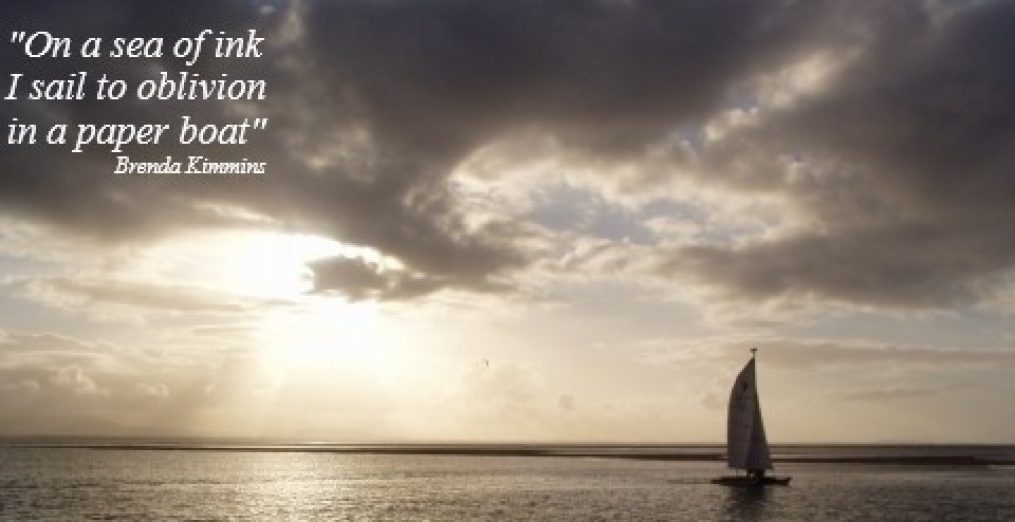






















































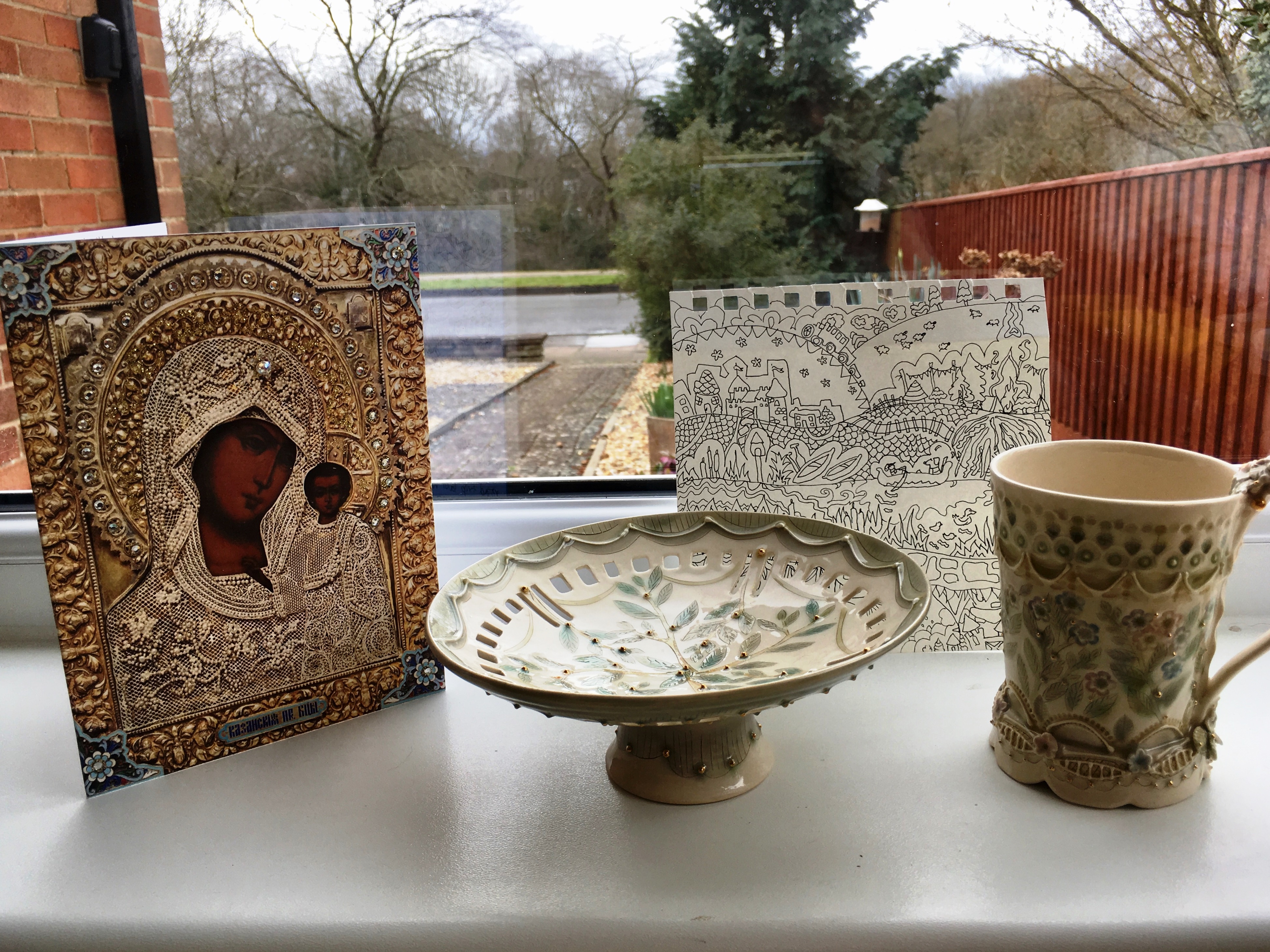










































 Before he gave his life to poetry, he had qualified as a surgeon-apothecary at Guy’s Hospital in London. But he had to give that up as his health was fading. There is a beautiful bronze statue of him in the garden of the hospital, which was unveiled in 2007 by another wonderful poet, Andrew Motion. I went to visit it with two of my dearest friends.
Before he gave his life to poetry, he had qualified as a surgeon-apothecary at Guy’s Hospital in London. But he had to give that up as his health was fading. There is a beautiful bronze statue of him in the garden of the hospital, which was unveiled in 2007 by another wonderful poet, Andrew Motion. I went to visit it with two of my dearest friends.



















